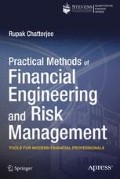Abstract
Chapters 1 and 2 presented various financial instruments in the form of market data familiar to Wall Street traders—namely, Bloomberg screens. Chapter 3 lays the mathematical foundation for the valuation of financial instruments, which depends in the first place on an analysis of the likelihood of future events using the tools of statistics and probability. This chapter shows you how to perform a statistical analysis of a given financial instrument by first identifying a suitable probability distribution and then calibrating it appropriately. Finally, this chapter discusses Risk measures such as value at risk, conditional value at risk, and the term structure of statistics.
Access this chapter
Tax calculation will be finalised at checkout
Purchases are for personal use only
Notes
- 1.
1 See, for example, Patrick Billingsley, Probability and Measure, Anniversary Ed., John Wiley and Sons, 2012; S. R. S. Varadhan, Probability Theory, American Mathematical Society, 2001.
- 2.
2 For discussion of countability conditions, see, for example, Patrick Billingsley, Probability and Measure, Anniversary Ed. John Wiley and Sons, 2012.
- 3.
3 Nassim Taleb, The Black Swan: The Impact of the Highly Improbable. Random House, 2007.
- 4.
4 For other methods of generating random numbers, see Paul Glasserman, Monte Carlo Methods in Financial Engineering. Springer, 2003.
- 5.
5 Repeats (3.26).
- 6.
6 See A. J. McNeil, R. Frey, and P. Embrechts, Quantitative Risk Management. Princeton University Press, 2005.
- 7.
7 See A. J. McNeil, R. Frey, and P. Embrechts, Quantitative Risk Management. Princeton University Press, 2005.
- 8.
8 H. Markowitz, Portfolio Selection: Efficient Diversification of Investments (Cowles Foundation Monograph No. 16). Yale University Press, 1968.
- 9.
9 For mathematically rigorous definitions using σ-algebras and concepts of measurability, see P. Billingsley, Probability and Measure, Anniversary Ed., John Wiley and Sons, 2012.
Author information
Authors and Affiliations
Rights and permissions
Copyright information
© 2014 Rupak Chatterjee
About this chapter
Cite this chapter
Chatterjee, R. (2014). Statistical Analysis of Financial Data. In: Practical Methods of Financial Engineering and Risk Management. Apress, Berkeley, CA. https://doi.org/10.1007/978-1-4302-6134-6_3
Download citation
DOI: https://doi.org/10.1007/978-1-4302-6134-6_3
Published:
Publisher Name: Apress, Berkeley, CA
Print ISBN: 978-1-4302-6133-9
Online ISBN: 978-1-4302-6134-6
eBook Packages: Business and EconomicsBusiness and Management (R0)Apress Access Books

